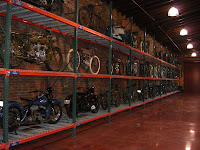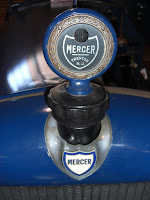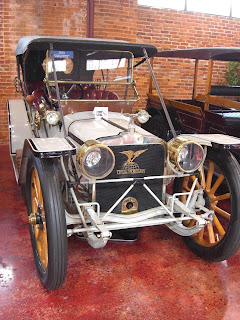 |
| Monty's MG Midget (In-process) |
Today, Monty Love and I went on a junket to Chattanooga. Monty is restoring an MG Midget and wanted to visit a company that reconditions and manufactures parts for these cars. He had been considering purchasing an adapter kit that they manufacture that allows the use of a Nissan 5-speed transmission in place of the original MG 4-speed. So we started the day heading for Rivergate Competition in Sale Creek, Tennessee, just a few miles north of Chattanooga.
We arrived there around 10:30 AM, after our obligatory boys' breakfast at Hardee's in Monteagle. The owner of Rivergate and his wife were leaving for the weekend so we didn't stay too long before heading back to Chattanooga to visit
Coker Tire Co. and Honest Charley Speed Shop.

On the way into town, Monty and I decided to get some lunch and trusted the GPS to find a local barbecue restaurant. We ended up at Shuford's Smokehouse. For such a serendipitous find, it was nothing short of spectacular barbecue. I have since looked it up on the Internet and learned that it has a five-star rating and has been featured on Turner Television's
Blue Ribbon, Best of the South TV show. After a delicious break, we headed to downtown Chattanooga to Coker Tire Company.
Perhaps a little background is in order. During the several times that I completed the Great Race antique car rally, members of the Coker family were
always a part of the event. Corky Coker, who now runs the company that his dad Harold started in 1958, was a major force in Great Race competition. He also sponsored the Great Race and was a major part of its management for several years. His team provided free tire repair services for those of us who had flat tires during the competition. In 2004, during an overnight stop in Jackson, Tennessee, Corky's crew had changed a tire for me that I wanted to have checked out. Monty and I had brought it to Chattanooga. As soon as we got to
Coker Tire, we dropped the tire off and went next door to
Honest Charley Speed Shop.
Honest Charley's has been around since 1948. Corky Coker acquired the company a few years ago after the original owners had passed away and the company had seen better days. It has become a viable business again, selling hot rod parts and components largely over the Internet. As Monty and I were looking at some items in the store, one of the staff asked if we cared about seeing "the collection." Actually, that was one more reason I had wanted to visit Coker Tire. Corky and his father have assembled a remarkable collection of vintage automobiles, many of which are from the first twenty years of automotive history. This period fascinates me.
 |
| A wall full of motorcycles! |
Monty and I were soon ushered in to a cavernous room. One wall was covered with heavy duty shelves that housed a magnificent collection of vintage (really vintage!) motorcycles. On the floor of the room were several rows of cars ranging from early twentieth century rarities to more recent sports cars. There were even several commercial vehicles - buses and trucks.

I follow Corky's blog and knew that he had recently acquired a pair of rare Mercers. For those who have never heard of the Mercer, it was a car built in Trenton, New Jersey, that was a major competitor of the more widely recognized Stutz Bearcat. The cars were only built from 1909 through 1919. Very few survive. The Mercer Model 35R so-called Raceabout was capable of over 90 miles per hour. In 1910, the company stated that it could be driven "safely and consistently" at over 70 miles per hour. I got to see Corky's 2 (!) Mercers. The collection is amazing for its breadth with names of marques long forgotten - National, American, Lozier, Thomas, and so on.
 |
American Underslung
(Note the axle above the frame!) |
Our host was a gentleman named Mike Goodman. He asked me a few questions and when he realized that I had known Corky through the Great Race he said, "Corky's here and will want to see you. Let me go tell him you're here." He disappeared, only to return with Corky accompanied by another long-time acquaintance, Wayne Bell. Wayne and Corky were preparing a car to participate in an
antique car rally this weekend in Bowling Green, Kentucky. Wayne is a colleague of my friend Andy Jattuso and was one of the first Great Race participants I had ever met. I introduced Monty and the four of of us had a great conversation.
Corky's son-in-law Greg Cunningham is also a Great Race veteran (and Winner!) and was working on the car headed to the rally. We got to chat with him as well. When we got done visiting the collection, we joined our guide Mike for a few minutes at the Red Lantern, a pleasant eating establishment next door. Not long afterwards, we had to say our goodbyes. I picked up my wheel and tire and we headed home. What a great day!










